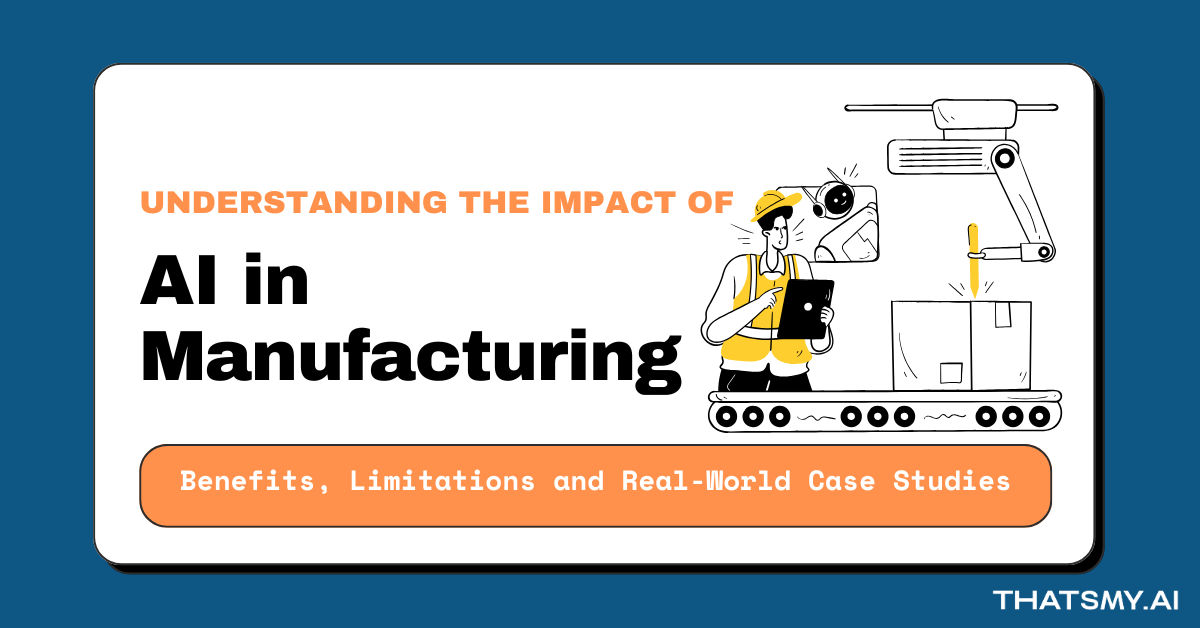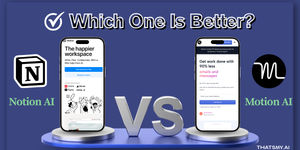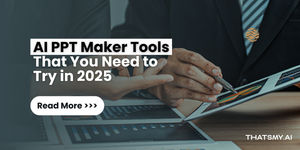AI is the new factory foreman—fast, tireless, and insanely smart. It’s cutting waste, predicting breakdowns before they happen, and turning ordinary production lines into precision machines. From Tesla’s robotic factories to BMW’s smart quality checks, AI isn’t just streamlining manufacturing—it’s rewriting the rulebook. Even small manufacturers are jumping in, using AI to work smarter, not harder. The result? More output, fewer errors, and leaner costs. This isn’t the future. It’s happening now.

I still remember my first visit to a traditional manufacturing plant as a young engineering student. The deafening noise of machinery, the intense heat from the furnaces, workers manually inspecting thousands of identical parts, and supervisors rushing to fix unexpected breakdowns. It was organized chaos—impressive, but clearly limited by human capabilities.
Last month, I walked through a modern AI-powered factory, and the contrast left me speechless. The facility operated with an almost magical efficiency—quiet, clean, and precise. A worker showed me her tablet where an AI system had just alerted her that a specific machine would need maintenance in exactly 37 hours. "Before this," she told me with a knowing smile, "we would have discovered the problem only after a breakdown that cost us lakhs in downtime. Now, we'll fix it during tonight's planned maintenance window."
This isn't science fiction. This transformation is happening right now in factories across India and the globe, revolutionizing the ₹230 lakh crore global manufacturing industry through the power of artificial intelligence.
The manufacturing sector is undergoing its most significant transformation since the introduction of assembly lines, with AI at the heart of this revolution. I've spent months researching this shift, speaking with factory workers, engineers, and executives to understand how AI is making manufacturing not just smarter and faster, but completely reimagining what's possible.
Before we dive into the real-world applications, let's understand what experts are saying about AI's impact on manufacturing:
Incredible Growth: Experts predict the global AI market in manufacturing could grow by over 40 times its current size—from ₹49,500 crore ($5.94 billion) in 2024 to ₹19.2 lakh crore ($230.95 billion) by 2034
Money Saved: AI-powered maintenance systems cut repair costs by 30%, reduce machine breakdowns by 70%, and slash downtime by 40%
Better Products: Quality control systems with AI reduce defects by up to 50%, so customers get nearly perfect products
New Job Opportunities: While some roles are changing, AI is expected to create over 12 million new jobs by 2025, with companies already searching for AI-skilled workers
More Production: Factory managers using AI report making 10-15% more products with the same resources, and increasing profits by 4-5%
These numbers tell a compelling story, but the real magic happens when we see how AI works inside actual factories.
Think about how frustrating it is when your car breaks down unexpectedly on a busy day. Now imagine if your vehicle could text you a week before: "My alternator will fail next Thursday—please get it fixed this weekend." This is exactly what AI does for factory equipment.
Arun, a maintenance supervisor at a manufacturing plant in Pune, shared his experience: "I was skeptical when they first installed the AI system. But within a month, it correctly predicted a critical motor failure that would have shut us down for days. Now I'm a believer."
The technology works by constantly watching for subtle warning signs:
Unusual vibration patterns in machines
Small temperature changes that humans wouldn't notice
Changes in electrical patterns
Abnormal sounds that human ears miss
Siemens uses thousands of sensors connected to AI systems across their factories. Their AI can predict equipment failures up to 36 hours in advance, cutting unexpected downtime by 25%. For a typical factory, this means crores of rupees saved annually.
Have you ever purchased something only to discover it's defective when you get home? AI is making this consumer headache increasingly rare.
Traditional quality control involves human inspectors checking random samples. Even the best inspectors get tired, miss things, or make mistakes. AI vision systems never get tired, can check every single product, and can spot defects invisible to the human eye.
Priya, a quality manager at an electronics manufacturer in Bangalore, told me: "Our human inspectors were catching about 92% of defects. After implementing AI vision systems, we're catching 99.7% of defects. Our customer returns have dropped dramatically."
BMW equipped its production lines with AI vision systems that:
Inspect every single component, not just samples
Detect defects as small as 0.1mm (thinner than a human hair)
Learn from each new defect they find, continuously improving themselves
Work 24/7 without breaks or fatigue
The payoff? Their defect rate dropped by 84% in just nine months.
Before AI, supply chain management mostly meant reacting to problems after they happened. Today, AI helps manufacturers anticipate issues before they occur.
Modern AI supply chain systems analyze many factors simultaneously:
Global shipping data and port congestion
Weather disruptions
Social media-driven consumer trends
Political impacts on material supply
Historical buying patterns and seasonal shifts
Rajesh, a supply chain director at a consumer goods company, explained: "Last year, our AI system detected unusual activity at a major port in Southeast Asia and predicted delays three weeks before they were publicly announced. We rerouted our shipments and avoided a major production stoppage."
Toyota's AI-powered supply chain systems have helped them reduce inventory costs by 17% while simultaneously decreasing stock outs by 74%. They're saving money while ensuring they have the right materials exactly when needed—a winning combination.
Now that we've seen how AI makes manufacturing smarter, let's look at how it makes everything happen faster.
Traditional production lines run according to fixed settings until an engineer changes them. AI has introduced something revolutionary: production lines that continuously improve themselves.
At Tesla's Gigafactories, AI systems constantly analyze every aspect of production, making thousands of tiny adjustments daily to improve efficiency. The AI might notice that slowing one robot by 0.2 seconds creates better synchronization with the next station, boosting overall output.
Manoj, an engineer who visited Tesla's facility, shared: "What amazed me wasn't the robots—it was how the entire system worked together like a living organism, constantly evolving and improving itself without human intervention."
Unlike traditional factories that improve through occasional engineering projects, these AI-powered lines get better every single day.
In traditional manufacturing, the decision process follows a slow path:
Collect data from the factory floor
Analyze it in meetings
Make decisions after discussion
Implement changes days or weeks later
AI collapses this entire process to milliseconds.
General Electric's factories use AI to make thousands of operational decisions per minute without waiting for human approval. When materials run low, equipment performance changes, or orders shift, the system automatically adjusts to maintain optimal production.
Sanjay, a production manager who implemented a similar system, told me: "Before AI, adapting to a major change in orders could take days of replanning. Now our system recalculates the optimal production sequence instantly. What took days now happens automatically in seconds."
Perhaps the most important innovation isn't robots replacing humans—it's humans and robots working together as partners.
At BMW's production facilities, collaborative robots (cobots) handle repetitive, physically demanding tasks while humans focus on complex assembly steps requiring judgment and dexterity.
Divya, an assembly line worker at an automotive plant, shared her experience: "When they first brought in the robots, I was worried about my job. But now I work alongside them, and my job is actually better. The robot handles the heavy lifting that used to hurt my back, while I do the precision work that robots can't handle. I go home without pain, and we produce more cars than before."
This collaboration creates a system that's more powerful than either humans or robots could achieve alone.
Despite the amazing benefits, implementing AI isn't always smooth sailing. Let's look at the real challenges and how companies are overcoming them:
Implementing comprehensive AI systems requires significant upfront investment:
Installing sensors throughout production equipment (₹8-17 lakh per production line)
Setting up computing infrastructure (₹42-85 lakh for mid-sized operations)
Hiring AI specialists (₹25-60 lakh annual salary per expert)
Integrating with existing systems (often the most expensive part)
For smaller manufacturers, these costs can seem prohibitive. However, new options are making AI more accessible:
Solutions for Smaller Manufacturers:
Start small: Begin with one high-value application rather than a factory-wide implementation
AI-as-a-Service: Subscription-based AI solutions with much lower upfront costs
Government incentives: Many states now offer subsidies for digital manufacturing upgrades
Phased implementation: Spreading costs over 2-3 years while gaining benefits incrementally
Vijay, owner of a medium-sized auto parts manufacturing business in Gujarat, explained his approach: "We couldn't afford a complete AI overhaul, so we started with just predictive maintenance on our most critical machine. The savings from preventing downtime paid for the system in 11 months, and we're now expanding to other areas."
AI systems need large amounts of high-quality data to function properly. Many manufacturers face significant obstacles:
Old machines without sensors or data connections
Different systems producing incompatible data formats
Missing or low-quality historical data
Information trapped in separate departments
Start collecting now: Even basic data collection today creates valuable historical data for future AI
IoT retrofitting: Adding sensors to older equipment (often more affordable than replacing machines)
Data standardization projects: Creating common formats across systems
Cross-functional teams: Breaking down information silos between departments
A production engineer at a textile manufacturer shared: "We couldn't afford to replace our 15-year-old looms, so we added simple vibration and temperature sensors to them instead. It cost less than 5% of new machines, but gave us 80% of the predictive capabilities."
Perhaps the most sensitive challenge is workforce transformation. While some jobs will change or disappear, new roles are emerging.
Contrary to common fears, most successful AI implementations don't result in mass layoffs. Instead, they lead to:
Workers shifting to higher-value tasks
New roles supervising and maintaining AI systems
Increased production requiring additional workers in other areas
Improved competitiveness preserving jobs that might otherwise be lost to overseas competitors
Transparent communication about how AI will and won't affect jobs
Extensive retraining programs for existing employees
Creating clear career pathways from traditional roles to AI-augmented positions
Involving workers in AI implementation to leverage their knowledge
Ravi, a factory worker for 22 years at a consumer electronics plant, shared his journey: "When they brought in the robots, I was given the choice: learn to manage the new automated line or take a different position. I chose to learn. At 45, I became a student again. Now I earn 30% more than before, and my job is less physically demanding."
The AI revolution in manufacturing is just beginning. Here are four emerging trends that will shape the factories of tomorrow:
The next evolution moves beyond smart factories to fully autonomous operations. Companies like Foxconn are developing facilities that run with minimal human supervision.
These autonomous factories can:
Switch production from one product to another without human setup
Fix many of their own problems
Adjust operations based on electricity costs at different times of day
Run 24/7 with just a skeleton crew of supervisors
While fully autonomous factories aren't yet widespread, we're seeing elements of this technology in specific production areas today.
AI is moving from optimizing existing designs to creating entirely new ones.
Here's how it works:
Engineers input basic requirements (strength needed, weight limits, available materials)
AI generates hundreds or thousands of possible designs
Each design is tested virtually through simulation
The system learns from each iteration, continuously improving
General Motors used AI to redesign a seat bracket. The AI-created design was 40% lighter and 20% stronger than the human-designed version. The computer explored unusual shapes that no human engineer would have considered.
Deepak, a product design engineer, described working with generative AI: "It's like having a thousand creative engineers working alongside you, each proposing different approaches. It doesn't replace my job—it gives me superpowers."
Traditional manufacturing favors identical mass production. AI is enabling mass customization—making unique products for individual customers at nearly the same cost as standard items.
Adidas's Speedfactory uses AI to produce highly personalized shoes at scale. Customers receive footwear designed specifically for their foot shape, running style, and preferences, but manufactured with the efficiency of standard models.
The implications extend far beyond shoes. From personalized electronics to custom furniture produced at mass-production prices, AI is making "batch size one" economically viable across industries.
AI is becoming a powerful ally in sustainable manufacturing:
Energy optimization: AI systems reduce energy use by 10-20% by precisely matching consumption to needs
Material efficiency: Smart design and production planning cut material waste by 15-30%
Circular economy: AI-powered recycling systems identify and sort materials with over 95% accuracy
Carbon tracking: Intelligent systems monitor emissions throughout the supply chain
Neha, sustainability director at a packaging company, explained: "Our AI system identified a small change in our heating process that reduced energy consumption by 17%. We would never have discovered this pattern without AI analyzing thousands of variables simultaneously."
Ready to begin your AI journey? Here's a practical roadmap to get started:
Don't try to implement AI everywhere at once. Instead:
Look for processes with frequent problems or delays
Identify quality issues that impact customer satisfaction
Find tasks that are physically demanding for workers
Target areas with high energy or material waste
Quick Tip: Ask frontline workers where they see the biggest challenges—they often have the clearest insights into improvement opportunities.
You can't implement AI without data, so begin gathering it now:
Install basic sensors on key equipment
Ensure production data is being recorded and stored
Begin tracking quality issues systematically
Document maintenance history in digital format
Even simple spreadsheets are a good starting point if you don't have advanced systems.
You don't need to build custom AI systems from scratch:
Numerous vendors offer industry-specific AI solutions
Cloud platforms provide AI capabilities with minimal infrastructure
Start with proven, standardized applications before attempting custom development
Look for solutions with clear ROI calculators
Technology alone isn't enough—your team makes the difference:
Provide basic AI literacy training to all relevant staff
Identify tech-savvy employees who can champion new systems
Create a clear vision of how AI will improve (not threaten) jobs
Celebrate and reward early adopters and those who embrace change
Begin with a pilot project that can show quick results:
Choose a contained area where success is measurable
Set clear metrics for what success looks like
Plan for rapid expansion once the pilot proves successful
Document lessons learned to improve future implementations
Vikram, IT director at a mid-sized manufacturer, shared his experience: "We started with just one production line using a simple predictive maintenance system. Within three months, we had proven results, and within a year, we had expanded to the entire factory. Starting small allowed us to learn and adjust before scaling up."
The factories of tomorrow are being built today. Across India and around the world, manufacturers are discovering that AI isn't just another technology upgrade—it's a fundamental transformation in how things are made.
From the small auto parts factory in Gujarat to the massive Siemens plants in Germany, companies of every size are finding ways to harness AI's power. The market's projected growth from ₹49,500 crore to ₹19.2 lakh crore by 2034 isn't just a statistic—it's a signal of how manufacturing is being reinvented.
The manufacturers who thrive will be those who:
View AI as a journey, not a destination
Invest in both technology and people
Start with clear problems rather than chasing shiny solutions
Build a culture that embraces continuous learning and change
As Sundar, a veteran factory manager with 30 years of experience, told me: "In all my years in manufacturing, I've never seen a technology that offered so much potential. The companies that embrace AI today will be the leaders of tomorrow. Those that wait will struggle to catch up."
The question isn't whether AI will transform manufacturing—it's already happening. The question is: Will you be at the forefront of this revolution, or trying to catch up?
The future of manufacturing is intelligent, efficient, sustainable, and human-centered. And it's being created right now, one smart factory at a time.
Sign up to gain AI-driven insights and tools that set you apart from the crowd. Become the leader you’re meant to be.
Start My AI Journey
ThatsMyAI
2 April 2025

ThatsMyAI
31 March 2025

ThatsMyAI
21 March 2025

ThatsMyAI
22 February 2025